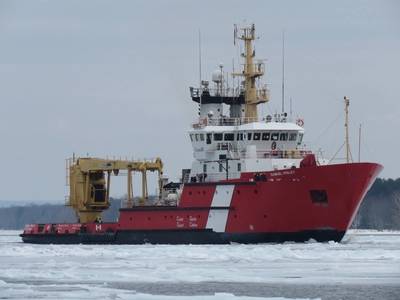Canadian Coast Guard Begins Icebreaking on the Great Lakes
The Canadian Coast Guard’s annual icebreaking season on the Great Lakes, which provides assistance to the shipping industry, is underway. Working in partnership with U.S. Coast Guard District 9, the Canadian Coast Guard has two icebreakers assigned to the Great Lakes for the entire winter season: CCGS Griffon and CCGS Samuel Risley. These vessels are supported as required by additional Coast Guard vessels during the spring icebreaking season.
Although the St. Lawrence Seaway, Welland Canal and Sault Ste. Marie Locks are closed during the winter months, shipping is still active on the Great Lakes and connecting waterways, including Lake Erie, Detroit River, Lake St. Clair, St. Clair River, Lake Huron, St. Marys River, and Georgian Bay.
This icebreaking season is different than usual due to the COVID-19 pandemic, and Coast Guard is working closely with organizations and governments, industry and other partners to make decisions based on the best advice and guidance available from federal, provincial and municipal health authorities. The Coast Guard continues to maintain normal levels of operation during the COVID-19 pandemic, while following strict National Standard Operating Procedures to prevent the spread of the virus. This includes extra sanitation practices for all Coast Guard crew, such as frequent hand-washing, appropriate personal protective equipment (PPE), and enhanced cleaning protocols onboard vessels.
Icebreaking requests are coordinated by Coast Guard’s Icebreaking Office in Montreal, along with the USCG. Daily operational conference calls are held between industry representatives and Coast Guard officials, who provide updates from both countries about ice extent, concentration, and thickness. Ice condition updates are provided by Environment and Climate Change Canada, and also gathered from ice reconnaissance flights, using both Canadian and United States Coast Guard helicopters.
In the 2019-2020, in Central Region and the Great Lakes, the Canadian Coast Guard responded to 80 requests for icebreaking. In the same season, both Coast Guards directly assisted 58 ship transits on the Great Lakes.
Marine Communications and Traffic Services in Sarnia, ON, and Prescott, ON, are in contact with mariners 24-hours-a-day providing information, managing marine traffic, and responding to calls for assistance. Winter maritime search and rescue operations are coordinated by the Joint Rescue Coordination Centre in Trenton, ON. Coast Guard icebreakers and other vessels may be called upon to help. Aircraft from the Department of National Defense and USCG are also involved in maritime search and rescue operations, as necessary.
In addition to icebreaking for the shipping industry, both Coast Guards work to prevent the formation of ice jams and flooding in communities. Problems occur when ice accumulates and blocks the flow of a river. That obstruction, known as an ice jam or ice plug, can cause flooding as water builds up and overflows the banks. Coast Guard ships are also at the ready to respond to environmental incidents or other urgent or humanitarian emergencies.
Bernadette Jordan, Minister of Fisheries, Oceans and the Canadian Coast Guard, said, “Icebreaking is an essential service provided by the Coast Guard that helps both the Canadian and United States economies remain active during the winter months. By collaborating with the United States Coast Guard and working closely with partners, maritime shipping on the Great Lakes can be done safely and efficiently, which ultimately allows Canada to play a vital role in economic activity and shipping maritime commerce. Our experienced crews and staff ensure cargo and goods continue to move, while safely maintaining operations during the COVID-19 pandemic.”














